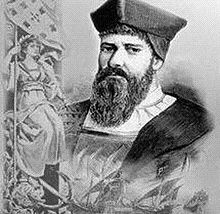João da Nova
João da Nova [ ˈʒu̯ɐ̃u̯ dɐˈnɔvɐ ] (* around 1460 in Castillo de Maceda , Galicia , † 1509 in Cochin ) was a Galician navigator and explorer in the Portuguese service.
Life
Da Nova came from the noble family Novoa de Maceda , who were wealthy in the Galician region around Ourense . Like many Galician nobles, he entered Portuguese services and is considered to be the discoverer of the islands of Ascención and St. Helena .
Because of his origins, he was also known as João Galhego or Gallego . In Spanish sources he is also listed as Juan de Nova . The Galicians call their compatriot Xoán de Novoa .
Known as João da Nova as early as 1480 , he earned a number of services in Portuguese politics and was appointed royal city lord or governor ( alcaide ) of Lisbon , among other things .
On March 5, 1501 , under his command, before the return of Pedro Álvares Cabral's fleet , the third royal Portuguese expedition with four Naus headed for India . Two (some sources assume three) Naus were financed by the Crown, the other two ships by a consortium of private capital led by the Florentine merchant Bartolomeo Marchione . In addition to da Nova as commander-in-chief, Francisco de Nabay, Fernão Vicente and Diogo Barboza commanded the remaining three ships.
On the outward journey, the expedition discovered today's island of Ascension between May 13 and 15, 1501 , which was christened by Da Nova Conceição and which was given its current name by Afonso de Albuquerque . In India, Da Nova established a new Portuguese trading post in Cannanore , north of Calicut . Supported by the Portuguese of the Cabral expedition who remained in India, da Nova achieved a first sea victory against the fleet of the ruler of Calicut.
He returned home with a rich load of spices and discovered the island of St. Helena on May 21, 1502 .
In 1506 da Nova commanded again a Nau, the Flor de la mar , in the second squadron under Afonso de Albuquerque in an expedition commanded by Tristão da Cunha and Albuquerque totaling 16 Naus. At the entrance to the Red Sea , the six Naus Albuquerques separated from the da Cunhas squadron, which was heading directly for the Indian coast. During the pirate war that Albuquerque waged against Arab and Egyptian ships, da Nova was distinguished by his courage, but also his disobedience. There were major differences and arguments between da Nova and Albuquerque over the status and rank of both and the implementation of royal directives. These disputes went to the brink of mutiny.
On arrival in India, da Nova brought an action against Albuquerque with Viceroy Francisco de Almeida . It was not until 1509 , after the arrival of the fleet under the Marshal of the Kingdom of Portugal, Fernando Coutinho, that this conflict could be resolved.
Da Nova distinguished itself again in the naval battle of Diu under Francisco de Almeida, in which an Arab-Egyptian-Indian fleet was destroyed and brought the Portuguese to naval supremacy in the western Indian Ocean for about 100 years .
João da Nova died in Cochin, India in 1509 .
See also
| personal data | |
|---|---|
| SURNAME | Nova, João there |
| BRIEF DESCRIPTION | Galician navigator and explorer in Portuguese service |
| DATE OF BIRTH | around 1460 |
| PLACE OF BIRTH | Castillo de Maceda , Galicia |
| DATE OF DEATH | 1509 |
| Place of death | Cochin |
